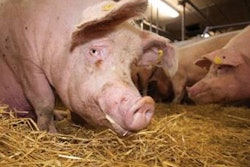Two years after Dublin (Ireland), more than 5000 people gathered in Chongqing (China) for the 25th International Pig Veterinary Society Congress. Three communications focused on the potentiated zinc oxide from Animine (HiZox).
An experiment from Ghent University (Belgium) compared the effect of different sources and levels of zinc oxide on the growth of enterobacteria in the small intestine of weaned piglets. Populations of E.coli and coliforms were reduced by regular zinc oxide at pharmacological dosage and by HiZox at nutritional dosage, whereas a source of encapsulated zinc oxide, supplemented at two dosages, showed no effect.
In a study conducted at the Institute of Subtropical Agriculture, Chinese Academy of Sciences (Hunan Research Center of Livestock and Poultry Sciences), the effect of conventional zinc oxide and HiZox was assessed on piglets weaned at 21 days. Basal corn-soybean meal diet was supplemented with a standard premix (100 mg/kg Zn from zinc sulfate) for the negative control, positive control included 3 kg/T of regular ZnO, and HiZox was supplemented at two dosages: 200 and 500 mg/kg. Low doses of the potentiated zinc oxide improved piglet weight gain and diarrhea rate to the same extent than the pharmacological dosage of the regular zinc oxide.













